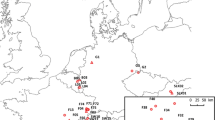Abstract
Plants of Dianthus carthusianorum from a calamine (zinc–lead) waste heap and from unpolluted stands were compared in the field and under controlled laboratory conditions. It was found that the waste-heap plants differed significantly from those in the normal population in respect to the following morphological traits: lower weight of aerial parts, shorter and narrower leaves, smaller number of leaves per plant. In combination with shorter, less numerous shoots, these features reduce the transpiration area of the plants. The general habit (predominance of forms with short and trailing shoots) of the waste-heap population points to adaptation to a xeric environment. Under controlled conditions all of the above traits were maintained through three successive generations. They are thus genetically controlled. Root tolerance tests showed that the waste-heap plants had higher tolerance to zinc and lead. These results indicate that strong selection processes have generated a clear ecotypical differentiation for heavy metal tolerance and drought tolerance in a zinc–lead-rich waste-heap population of D. carthusianorum (variety).
Similar content being viewed by others
References
Bringezou K, Lichtenberger O, Leopold I and Neumann D 1999 Heavy metal tolerance of Silene vulgaris. J. Plant Physiol. 154, 536-546.
Brown G and Brinkmann K 1992 Heavy metal tolerance in Festuca ovina L. from contaminated sites in the Eifel Mountains, Germany. Plant Soil 143, 239-247.
Davies K L, Davies M S and Francis D 1991 Zinc-induced vacuolation in root meristematic cells of Festuca rubra L. Plant Cell Environ. 14, 399-406.
Dobrzanska J 1955 Flora and ecological studies on calamine flora in the district of Boleslaw and Olkusz. Acta Soc. Bot. Pol. 24, 357-417 (in Polish).
Ernst W H O 1974 Schwermetallvegetation der Erde. Fischer Verlag, Stuttgart.
Ernst W H O 1996 Bioavailability of heavy metals and decontamination of soils by plants. Applied Geochem. 11, 163-167.
Ernst W H O and Nelissen H J M 2000 Life-cycle phases of zinc-and cadmium-resistant ecotype of Silene vulgaris in risk assessment of polymetallic mine soils. Environ. Pollut. 107, 329-338.
Godzik B 1991 Accumulation of heavy metals in Biscutella laevigata (Cruciferae) as a function of function of their concentration in the substrate. Bot. Stud. 2, 241-246.
Grodzinska K, Korzeniak U Szarek-Lukaszewska G and Godzik B 2001 Colonization of zinc mine spoils in the southern Poland-preliminary studies on vegetation, seed bank. Fragmenta Floristica Geobot. 45, 123-145.
Harmens H, Gusmao N G C P B Den Hartog PR Verkleij J A C and Ernst W H O 1993 Uptake and transport of zinc in zinc-sensitive and zinc-tolerant Silene vulgaris. J. Plant Physiol. 141, 309-315.
Küpper H, Lombi E, Zhao F and McGrath SP 2000 Cellular compartmentation of cadmium and zinc in relation to other elements in the hyperacumulator Arabidopsis halleri. Planta 212, 75-84.
Podbielkowski Z and Podbielkowska M 1992 Plant environmental adaptation. Wydawnictwa Szkolne i Pedagogiczne, Warsaw (in Polish).
Poulter A, Collin HA, Thurman DA and Hardwick K 1985 The role of the cell wall in the mechanism of lead and zinc tolerance in Anthoxanthum odoratum L. Plant Sci. 42, 61-66.
Rostanski A 1997 Spontaneous flora on coal spoil heaps in Upper Silesia (Poland). In Contaminated and Derelict Land. International Symposium on Geotechnics Related to the Environment, Cracow.
Rostanski A 1998 Anthropophytes and apophytes in colonization process on the post-industrial heaps in Upper Silesia region. Phytocoenosis 10, 199-201.
Salt DE, Smith RD and Raskin J 1998 Phytoremediation. Annu. Rev. Plant. Physiol. Plant Mol. Biol. 49, 643-68.
Schat H, Vooijs R and Kuiper E 1996 Identical major gene loci for heavy metal tolerances that have independently evolved in different local populations and subspecies of Silene vulgaris. Evolution 50, 1888-1895.
Smith RAH and Bradshaw DA 1979 The use of metal tolerant plant populations for the reclamation of metalliferous wastes. J. App. Ecol. 16, 595-612.
Sychowa M 1992 Species: Dianthus L., Pink. In Ed. A. Jasiewicz. Polish Flora. Vascular Plants, Vol. 3, pp 230-242. Institute of Botany, Polish Academy of Science, Cracow (in Polish).
Wenzel W W and Jockwer F 1999 Accumulation of heavy metal in plants grown on mineralised soil of the Austrian Alps. Environ. Pollut. 104, 145-155.
Whiting S N, Leake J, McGrath S P and Baker A J M 2000 Positive responses to Zn and Cd by roots of the Zn and Cd hyperacumulator Thlaspi caerulescens. New Phytol. 145, 199-210.
Wierzbicka M 1999 Comparison of lead tolerance in Allium cepa with other plants species. Environ. Pollut. 104, 41-52.
Wierzbicka M and Panufnik D 1998 The adaptation of Silene vulgaris to the growth on a calamine waste heap (S. Poland). Environ. Pollut. 101, 415-426.
Wierzbicka M and Zyska A 1999 Zinc tolerance of Silene vulgaris populations from a calamine waste heap near Olkusz, Poland. In Trace elements-Effects on Organism and Environment. pp. 215-219. Silesia University, Katowice.
Wierzbicka Mand Potocka A 2002 Lead to tolerance of plants growing on dry and on moist soils, Acta Biol. Cracoviensia, Ser. Bot. 44 (in press).
Wierzbicka M and Rostanski A 2002 Microevolutionary changes in the ecotypes of calamine waste heap vegetation near Olkusz, Poland: A review. Acta Biol. Cracoviensia Ser. Bot. 44 (in press).
Wilkins D A 1957 A technique for the measurement of lead tolerance in plants. Nature 180, 37-38.
Wilkins D A 1978 The measurement of tolerance to edaphic factors by means of root growth. New Phytol. 80, 623-633.
Author information
Authors and Affiliations
Corresponding author
Rights and permissions
About this article
Cite this article
Załecka, R., Wierzbicka, M. The adaptation of Dianthus carthusianorum L. (Caryophyllaceae) to growth on a zinc–lead heap in southern Poland. Plant and Soil 246, 249–257 (2002). https://doi.org/10.1023/A:1020612930364
Issue Date:
DOI: https://doi.org/10.1023/A:1020612930364




